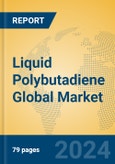The Liquid Polybutadiene (LPB) market is a niche yet vital segment of the polymer industry, characterized by its versatility and high-performance properties. LPB, a low-molecular-weight polymer, is prized for its flexibility, chemical resistance, and adhesion, making it a key material in automotive tires, sealants, and electrical insulation. The market is highly concentrated, with top players - Cray Valley, Synthomer, Idemitsu Kosan, Evonik Industries, and Kuraray - accounting for over 90% of revenue share. In H1 2022, Synthomer completed a de-bottlenecking project at its Stallingborough, UK plant, boosting capacity and signaling strategic investments to meet demand.
LPB’s applications span automotive (30%-35%), sealing and coating materials (25%-30%), electrical insulation (20%-25%), and housing and construction (10%-15%), with North America, Europe, and APAC leading consumption. The market benefits from steady demand in tire manufacturing and construction, though it faces challenges from raw material price volatility and competition from solid rubbers.
This product will be delivered within 1-3 business days.
LPB’s applications span automotive (30%-35%), sealing and coating materials (25%-30%), electrical insulation (20%-25%), and housing and construction (10%-15%), with North America, Europe, and APAC leading consumption. The market benefits from steady demand in tire manufacturing and construction, though it faces challenges from raw material price volatility and competition from solid rubbers.
Market Size and Growth Forecast
The global LPB market is estimated to reach USD 300 million to USD 350 million in 2025, with a projected CAGR of 3% to 4% through 2030, potentially expanding to USD 360 million to USD 430 million. This moderate growth reflects stable industrial demand and incremental innovations.Regional Analysis
- North America: Projected at 3% to 4%, with 30%-35% share, the U.S. leads with automotive and insulation uses. Trends focus on tire production and energy-efficient coatings.
- Europe: Forecasted at 3% to 4%, with 25%-35% share, Germany and the UK drive demand in automotive and construction. Trends emphasize sustainable materials.
- Asia Pacific: Anticipated at 4% to 5%, with 25%-30% share, China and Japan dominate with tire manufacturing. Trends highlight industrial growth and cost optimization.
- Middle East and Africa: Expected at 2% to 3%, with 3%-5% share, the UAE leads with construction needs. Trends focus on niche applications.
- South America: Projected at 2% to 3%, with 5%-10% share, Brazil emerges with automotive uses. Trends emphasize affordable solutions.
Application Analysis
- Automotive: Projected at 3% to 4%, with 30%-35% share, LPB enhances tire durability. Trends focus on EV tire innovations.
- Sealing & Coating Materials: Forecasted at 3% to 4%, with 25%-30% share, it improves weather resistance. Trends highlight eco-friendly sealants.
- Electrical Insulation: Anticipated at 3% to 4%, with 20%-25% share, LPB ensures flexibility. Trends focus on renewable energy cables.
- Housing and Construction: Expected at 2% to 3%, with 10%-15% share, it serves sealants. Trends emphasize durability.
Type Analysis
- Homopolymers: Projected at 3% to 4%, with 60%-70% share, they offer consistency. Trends focus on tire and insulation uses.
- Copolymers: Forecasted at 3% to 4%, with 30%-40% share, they enhance adhesion. Trends highlight coating innovations.
Key Market Players
- Synthomer: A UK leader, Synthomer excels in tire and coating solutions.
- Idemitsu Kosan: A Japanese firm, Idemitsu targets automotive applications.
- Evonik Industries: A German player, Evonik focuses on high-performance polymers.
- Cray Valley: A French company, Cray Valley leads in tire-grade LPB.
- Nippon Soda: A Japanese entity, Nippon Soda serves industrial uses.
- Kuraray: A Japanese firm, Kuraray emphasizes specialty applications.
- SIBUR: A Russian company, SIBUR boosts regional supply.
Porter’s Five Forces Analysis
- Threat of New Entrants: Low, due to high concentration and technical expertise barriers.
- Threat of Substitutes: Moderate, with solid rubbers competing, though LPB’s properties sustain demand.
- Bargaining Power of Buyers: Moderate, as large tire makers negotiate pricing, but niche uses limit options.
- Bargaining Power of Suppliers: Moderate-to-high, with raw material volatility affecting costs.
- Competitive Rivalry: High, with top five players dominating and investing in capacity.
Market Opportunities and Challenges
Opportunities
- Automotive Growth: EV tire demand boosts LPB use.
- Capacity Expansion: Synthomer’s 2022 project signals supply growth.
- Sustainable Trends: Eco-friendly sealants align with regulations.
- Emerging Markets: APAC’s industrialization offers potential.
- Industrial Uses: Insulation demand in renewables rises.
Challenges
- Raw Material Volatility: Butadiene price swings impact costs.
- Substitute Competition: Solid rubbers challenge in cost-sensitive areas.
- High Concentration: Top players limit new entrant scope.
- Regulatory Pressures: Environmental rules raise compliance costs.
- Market Maturity: Stable growth limits explosive expansion.
This product will be delivered within 1-3 business days.
Table of Contents
Chapter 1 Executive SummaryChapter 2 Abbreviation and Acronyms
Chapter 3 Preface
Chapter 4 Market Landscape
Chapter 5 Market Trend Analysis
Chapter 6 Industry Chain Analysis
Chapter 7 Latest Market Dynamics
Chapter 8 Trading Analysis
Chapter 9 Historical and Forecast Liquid Polybutadiene Market in North America (2020-2030)
Chapter 10 Historical and Forecast Liquid Polybutadiene Market in South America (2020-2030)
Chapter 11 Historical and Forecast Liquid Polybutadiene Market in Asia & Pacific (2020-2030)
Chapter 12 Historical and Forecast Liquid Polybutadiene Market in Europe (2020-2030)
Chapter 13 Historical and Forecast Liquid Polybutadiene Market in MEA (2020-2030)
Chapter 14 Summary For Global Liquid Polybutadiene Market (2020-2025)
Chapter 15 Global Liquid Polybutadiene Market Forecast (2025-2030)
Chapter 16 Analysis of Global Key Vendors
List of Tables and Figures
Companies Mentioned
- Synthomer
- Idemitsu Kosan
- Evonik Industries
- Cray Valley
- Nippon Soda
- Kuraray
- SIBUR



![Liquid Polybutadiene [LPBD] Market Size, Market Share, Application Analysis, Regional Outlook, Growth Trends, Key Players, Competitive Strategies and Forecasts, 2024 To 2032 - Product Image](http://www.researchandmarkets.com/product_images/12668/12668041_60px_jpg/liquid_polybutadiene_[lpbd]_market.jpg)




